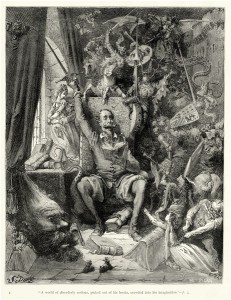On Don Quixote
“Too much sanity may be madness. And maddest of all, to see life as it is and not as it should be.”
Not all great literature is enjoyable even when profitable. Take Don Quixote for example. We recently read the great Spanish classic. Miguel Cervantes is to the Spanish what William Shakespeare is to the English. His masterpiece is required reading across Latin America. The iconic sculpture of Don Quixote and his sidekick Sancho Pansa is available at every tourist stand in Peru.
Don Quixote de la Mancha is acclaimed as the world’s first modern novel and the greatest work of Spain’s Golden Age. Yet, to be honest, I was glad we did not have to read from Spain’s silver and bronze age. Keeping with the Iberian penchant for ornamentation, the language is so elaborate and florid that you forget what the author is talking about by the time you reach the end of a sentence. My English abridgment was much easier to read than our students’ Spanish version and it was still dense.
Once you get past the language, the story is a burlesque parody. Yet, you can never exactly tell who or what the author is mocking. An otherwise insignificant middle-aged man of waning nobility reads too many adventure stories of medieval chivalry. Inebriated with the imaginary world of valiant cavaliers, terrifying dragons, evil wizards, and beautiful princesses, the protagonist decides to become a knight-errant. There is only one problem. That particular job-description disappeared from Spain centuries ago.
Undeterred by such minor historical details (or anything else), Don Quixote set out in search of adventure. His old nag becomes a magnificent war horse, a rusty antique becomes shining armor, a metal bowl morphs into a magical helmet and a homely country girl is the most beautiful woman in the world in whose honor Don Quixote rides and fights.
Eventually, an illiterate farm hand named Sancho Panza signs on as squires. Sancho Panza is simple-minded enough to believe Don Quixote at first but by the end of the book comes to realize the insanity of his employer. Interestingly, even after he grasps the knight’s madness, the squire still plays along, perhaps out of loyalty. Or perhaps traversing the country is more interesting that his boring life on the farm. For all his complaining, the loquacious Sancho seems to be having a good time.
The plot reads like a three stooge’s script except with more blood. In one chapter, Don Quixote mistakes a herd of sheep for opposing armies and kills several of the enemy with his lance. The shepherds defend their flock with slingshots and knock Don Quixote off his horse. He discovers that they also knocked out several of his teeth. In an earlier scene, the most famous of the book, the knight charges a windmill that he believes to be a giant. A canvas blade throws the knight into the air and almost kills him from the impact. Later, after Don Quixote frees a band of convicts, they stone, beat and rob him in response. It is all strangely funny in a slapstick sort of way.
Yet, if Don Quixote is deluded, and Sancho Panza is duped, then the normal people they meet are just plain cruel and wicked. An employer ties his servant boy to a tree and whips him mercilessly. A nobleman dishonors one woman and forces another into marriage involuntarily. When his wife escapes, he rides out with a group of thugs and abducts her from a convent where she is hiding. A duke and duchess play along with Quixote’s madness to mock both he and Sancho Panza with a series of almost sadistic practical jokes. Virtually every chapter involves violence. There is quite a bit of bloodshed and other bodily fluids. It is not a pleasant story.
***
As I read the book, it kept reminding me of someone I knew, but I could not quite put my finger on whom. This fictional description of 17th century Spain was surprisingly similar to real 21st century Peru. Life was harsh there. Life is harsh here. There is an alarming amount of cruelty in Peru, especially to the weak. The attitudes towards women have only degenerated since that time. Where we live many adults beat and abuse children remorselessly. An alarming number of men and women seem to take real pleasure in humiliating and hurting others. The characters in the story remind me of our neighbors.
That fortunately does not describe everybody here, but it does describe a significant segment of society. Injustice prevails in our courts and government. If anything, corruption has increased. Cervantes, who wrote his book from debtors’ prison, would feel at home in our city.
****
Then there is the whole issue of fantasy and reality and the consequences of living in one or the other. Don Quixote provokes conflict unnecessarily. Yet, if reality corresponded to his vision, then his actions would make perfect sense. The problem is that the world is not as he perceives it. Those are windmills and sheep not giants and armies. That is a cheap inn not a castle. The girl is a milkmaid, not a princess.
One of the ironies of the book is that the real world is so much worse than the old man’s fantasy. You almost come to prefer Don Quixote’s noble but whimsical imagination to the heartless and vulgar reality of seventeenth century Spain. At least this deluded knight was willing to die for a girl who in his eyes was beautiful. By contrast the upper class nobleman won’t even marry the woman he seduces and sneaks off to take another man’s bride.
There is some goodness among the characters of the novel. The shepherds are simple but virtuous people. The priest and the barber in the first book come across as genuinely decent men. A combination of their efforts and good fortune end up righting some of the wrongs. At one point they have to drag Don Quixote back home in a cage on a donkey, but they ultimately want to help not hurt him.
A great creative writing project would be to redo the plot to where the reader discovers that Don Quixote was the only sane person in town. What if, at the end, we realize that the old man really was a valiant knight, that the world truly was bewitched, and that his actions, far from doing harm had actually liberated the oppressed and defeated the wicked?
That was not Cervantes book but it would make a great story. It is one I would like to read.
***
The other morning I woke up and realized why Don Quixote seemed so familiar. He reminded me of myself. Like Don Quixote, I regularly find myself fighting giants, dragons and ogres of assorted shapes and sizes. My daily experience is often absurd or at least bizarre (see above about “bodily fluids”). I tend towards a melancholic, melodramatic larger-than-life view of life. The world I live in does not seem to correspond to the world I walk in. Finally, everybody around me is most certainly bewitched.
Whether all this is a humble confession or a self-congratulatory compliment remains to be seen.
I will leave the answer to the reader as I close for now; I see giants on the horizon than need thrashing.
Adios!
G.S.T.

